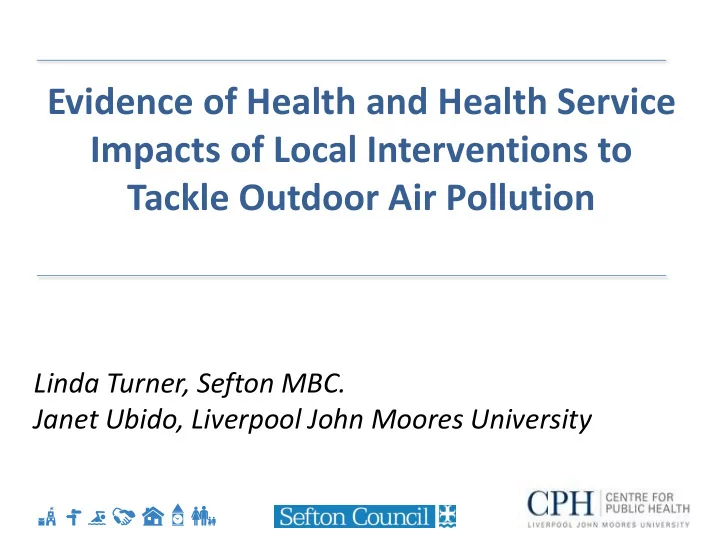

Evidence of Health and Health Service Impacts of Local Interventions to Tackle Outdoor Air Pollution Linda Turner, Sefton MBC. Janet Ubido, Liverpool John Moores University
Presentation Content • Context – Air pollution in Merseyside and Sefton – Why this evidence review was commissioned • Evidence review – Methodology – Findings • Discussion, conclusions and next steps
Merseyside - Sefton - Locality
Merseyside – PM 2.5 Annual mean ambient PM 2.5 Fraction of mortality attributable concentrations (2010) to anthropogenic PM 2.5 (PHOF) Merseyside Merseyside
Sefton – Air Pollution - AQMAs PM 10 24h mean 1 4 5 NO 2 annual mean 2 3
Sefton – Air Pollution – Sources NO x Emissions Major Roads 2012 NO x emissions by Vehicle Type at various locations 100 HGV 90 80 Proportion of NOx Emissions % Bus/Coach 70 60 50 LGV 40 30 20 Car 10 0
Health impacts of air pollution – local? Short term exposure to fine particles Asthma Lung function Admissions Death
Evidence Review Air pollution and health an association that is well documented: e.g. in 2010, up to 140,743 life-years lost in London due to NO2 and PM25 What can be done? Literature Guidelines for local action from e.g. DEFRA; Public Health England and WHO Do interventions work? We focussed on evaluating local air pollution interventions in terms of effects on: • health and • health service use
Findings Few studies examining the association between interventions to reduce air pollution and health impacts Of these, most use health benefit modelling - a technique developed due to practical difficulties in evaluation. Range of studies: • Active travel and low carbon driving • Low Emission Zones (LEZ) • Speed Management Zones • Congestion Charging • Natural Gas • Low Carbon Electricity Production • Cumulative interventions
Active travel and low carbon driving Health effects per million population in 1 year compared with business as usual Lower carbon Increased active London estimates emission vehicles transportation alone alone Premature deaths 17 530 Decreased by Years of life lost 160 5188 Decreased by Disability adjusted life years 160 7332 Increased by Co benefits: increased physical activity; community cohesion; road safety; reduced travel poverty; reduced congestion; climate change mitigation.
Low Emission Zones London LEZ: no health impacts demonstrated yet German LEZ: upgrading vehicle fleet = $1b health benefits = $2b Rome LEZ: residents along busy roads gained 3.4 days/person ( i.e. 921 YLG per 100 000 population) Amsterdam: average gain of 0.2 months of life expectancy
Speed Management Zones Improvements in air quality and health: 2 studies Rotterdam, of those living within 400m: 85% gained up to 1 month life expectancy, 15% gaining 1-3 months Barcelona decrease mortality rates by around 0.6% increase life expectancy by 0.15 months 40 fewer deaths each year
Congestion Charging London Congestion Charge gains of 183 years of life per 100,000 population overall 1,888 years of life were gained Stockholm congestion charging reduced emissions estimated to save five life-years per year Natural Gas Chile switching to compressed natural gas for public transport reduced urban PM emissions 36 avoided premature mortalities per year
Cumulative Interventions New Haven (US): Range of interventions applied, which led to: Large reductions in NOx significant improvements in health outcomes Modest reductions in PM significant decrease in numbers of CHD and asthma hospitalisations within small areas Detroit (US): Range of interventions targeted in areas of high population density predicted 130 avoided deaths and 16 avoided asthma hospitalisations in 2020 National Policy e.g. China’s ‘Blue Sky’ programme : regulation of industry combined with local initiatives. Led to improvements in urban air quality, resulting in a 50% reduction of the prevalence rate of bronchitis amongst schoolchildren.
Discussion, conclusions and next steps • Complexity, confounding, collaboration • Health benefit modelling • Building the evidence base • Usefulness to prompt debate, discussion, engagement
Discussion, conclusions and next steps • Complexity, confounding, collaboration • Health benefit modelling • Building the evidence base • Usefulness to prompt debate, discussion, engagement Linda.Turner@sefton.gov.uk & j.ubido@ljmu.ac.uk
Recommend
More recommend